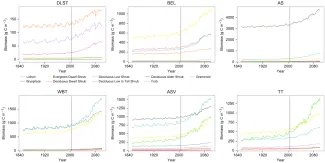Accurate simulations of high- latitude ecosystems are critical for confident Earth system model (ESM) projections of carbon (C) cycle feedbacks to global climate change. Land surface model components of ESMs, including the E3SM Land Model (ELM) within the Energy Exascale Earth System ModelE3SM, simulate vegetation growth and ecosystem responses to changing climate and atmospheric CO2 concentrations using different sets of plant functional types (PFTs) to represent heterogenous vegetation across the land surface. However, current land models such as ELM often represent arctic vegetation using only two PFTs (shrub and grass), thereby missing the diversity of vegetation growth forms and functional traits in the Arctic. Researchers used field observations of biomass and leaf traits across a gradient of plant communities on the Kougarok Hillslope field site oin the Seward Peninsula of Alaska to replace the original ELM configuration with nine arctic-specific PFTs (Figs. 4 and 5). The new arctic PFTs include: (1) nonvascular mosses and lichens, (2) deciduous and evergreen shrubs of various height classes, (including an alder- specific PFT), (3) graminoids, and (4) forbs. New PFTs were parameterized and evaluated using site-level trait and biomass measurements. Improvements relative to the original model configuration included much greater belowground biomass allocation, persistent fine roots, and rhizomes of nonwoody plants, and as well as better representation of variability in total plant biomass across sites with varying plant communities and depth to bedrock. Simulations through 2100 using the RCP8.5 climate scenario showed alder-dominated plant communities gaining much more biomass and lichen-dominated communities gaining much less biomass compared to with default PFTs. These results highlight how representing the diversity of arctic vegetation and confronting models with measurements from varied plant communities improves the representation of arctic vegetation in land surface models and Earth system model (ESMs).
For more information, please contact:
Benjamin Sulman
sulmanbn@ornl.gov

